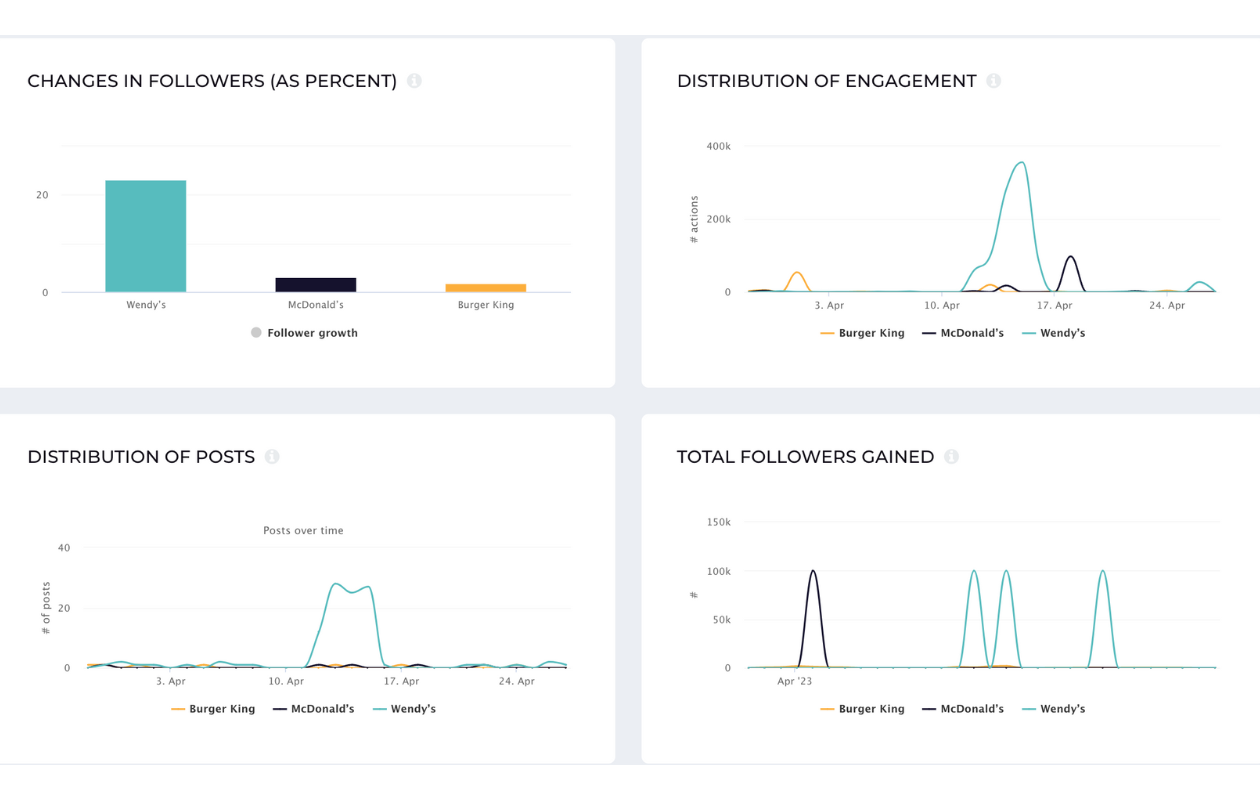They say comparison is the thief of joy - and that is true, except when you’re working in a competitive industry where you need to compare yourself to your competitors to know where you stand at all times.
In the age of the internet, no brand exists on an island. No matter if you’re targeting a large industry or a small niche, you will have your fair share of competitors.
And you need to know what they’re up to, what’s working for them and what’s not, and use those insights to drive growth for your own brand.
Carry on reading to figure out how to gain competitive insights from and using social media and why they are extremely important for creating a powerful yet realistic strategy for your brand.
Using competitive insights to improve your strategy
1. Why do you need competitive insights?
2. How to extract competitive insights from social media data
3. Getting competitive insights from non-measurable data
4. How to make the best of competitive insights
1. Why do you need competitive insights?
If you’re just starting out, you might be inclined to think that analyzing your own brand’s social media performance is enough.
By using social media analysis and benchmarking tools like Socialinsider, you have a massive amount of data at your fingertips, and you can use that data to draw insights about your top posts, campaign performance, hashtags, posting times and much more.
You can track the evolution of your most important metrics across long periods of time and pinpoint different trends and spikes.
For instance, if you need a bird’s eye view of your engagement evolution (per profile or at a brand level), Socialinsider can help you map out the distribution of engagement for your selected timeframe.

Same for Reels impressions on Instagram:

Or TikTok video plays evolution:

And the list goes on and on.
Analyzing your performance helps you determine which of your posts do best and develop some theories as to why that is happening.
In other words, you can learn from your past performance, identify what is working and what is not, and use these insights to improve your social media strategy moving forward.
But you can do much more than that.
If you’re only auditing your own performance, you are missing out on a lot of lessons and you risk not seeing the whole picture.
To have a complete understanding of your performance across all channels and gain competitive insights, you need to perform a competitor analysis on a regular basis, and compare those results against your own brand’s data.
If the data is telling you, for instance, that videos are performing very well for your competitors, you should take that as your cue to start implementing videos into your strategy - provided it makes sense for your brand.
Competitive insights are the missing puzzle piece and the cornerstone of any successful social media strategy. You need them in order to:
- Have a benchmark against which you can measure your performance
- Understand your competitors’ content strategies
- Uncover gaps and opportunities in your niche or industry
- See what’s working for your competitors and what’s not
- Get ideas for great social media content to share
2. How to extract competitive insights from social media data
Social media can be a real goldmine when it comes to competitors' analysis and benchmarking, and for getting competitive insights. You only need to know where to start. So here’s an action plan:
Step 1: Get access to reliable competitive data
With Socialinsider, you can have all the competitive data available to you at a glance, in a unified dashboard packed with charts and numbers.
All you need to do to get this data is to add your competitors in the platform by selecting the social media profiles you want to focus on.
Step 2: Do an in-depth competitive analysis
From here, it’s your choice whether you want to look at a macro or a micro level (benchmarks vs campaigns).
Socialinsider’s Benchmarks feature comes in handy by providing a context in which you can judge your own performance.
To give a specific competitive insights example, if you’re planning to bring your brand to TikTok and you don’t know how active your competition is on this platform, you can use the Benchmarks feature to gain insights on their TikTok activity.


Campaigns, on the other hand, give you a more focused view of competitive data.
Through this feature, you can compare your social media campaigns to your competitors, see how much they’ve contributed to a particular campaign, what’s working for them and what’s not and use those insights to improve your own content.

You can find more about these two ways of looking at competitive data in our article on social media competitive intelligence. Additionally, you can get some indirect competitive insights by looking at our all-free, instantly downloadable social media stats for 2023.
Step 3: Connect the dots in your dataset
Regardless if you’re looking at your own social media performance data or you’re keeping tabs on your competitors, it’s extremely important to learn to correlate your findings.
You will have a much better chance of deriving insights from data if you connect multiple data points and put them into context.
If you notice, for instance, a spike in follower growth for one of your competitors, check to see if you can connect that event to other data points. See if you can find any top performing posts from that same date, shortly before or after.
Check the engagement rate and posting times. Only by looking at all the important metrics holistically will you be able to understand what led to a particular event.
In other words, look at competitive data through the eyes of a storyteller.
3. Getting competitive insights from non-measurable data
Social media competitive analysis does provide us with a lot of data to play with. But not all competitors' insights must come from data. There’s some value in simply analyzing your competition’s presence on social media without focusing on the numbers.
Using social media, you can gain insights about your competitors on metrics that can’t be measured in traditional ways, such as tone of voice, brand personality, community management etc.
In other words, how they talk to their audience, how quick they are to respond, how open they are to feedback, how friendly or formal they choose to be, etc.
This part of the process cannot (and shouldn't) be automated , but it’s worth spending extra time “lurking” on your competitors’ social media profiles, gathering insights from non-measurable data.
4. How to make the best of competitive insights
Your job is not done once you gain all the competitive insights you need. You need to figure out the best way to process these insights so that they turn into valuable lessons and actionable insights, not drawbacks.
Create an action plan
Be strategic about the competitive insights you gather. Turn all your key competitive insights into action points and use them to improve your social media strategy.
By identifying clear actions that can be taken in response to your competitors’ actions, you will have a much clearer idea on how to shape your strategy moving forward.
Compare wisely
Another important thing to remember when “hunting” for competitive insights is to make realistic comparisons. Remember that saying, “don’t compare your chapter 1 to someone else’s chapter 11”? Well, the same applies here.
Pick competitors from your own league, more or less. There’s nothing wrong with being ambitious and choosing some competitors that are slightly above you, but do try to remain realistic.
Analyzing competitors with a far larger market share may seem tempting, but it’s a slippery slope.
Yes, there are lessons to be gleaned from studying industry giants, but more often than not, this analysis will not produce any competitive insights that you can actually use in your strategy.
Final thoughts
With the growing competition in the social media sphere, securing enough engagement and conversions is becoming more and more difficult for social media marketers.
But just because you’re competing with other businesses, that doesn’t mean you can’t still learn from one another.
At the end of the day, your social media strategy will benefit the most from competitive insights, because you will be able to plan your efforts knowing exactly what works best in your industry.








